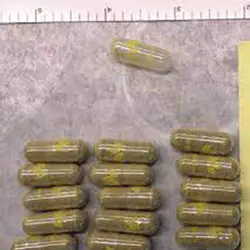DRUGS: WHAT YOU
NEED TO KNOW Booklet

Signs and Symptoms of Kratom Use

Courtesty of DEA.gov
Kratom is the name of a tree native to Thailand, Malaysia, Indonesia, and Papua New Guinea. The scientific name of the tree is Mitragyna speciose. The locals in those areas chew the leaves to provide more energy and endurance during work, much as cocaine leaves are chewed in South America.
In the last decade, however, thousands of pounds of raw and processed kratom have been seized as they were being shipped across international borders to America.1 Kratom is not illegal in America under federal law but many states have banned the substance because of reports of severe adverse effects. However, the FDA has issued instructions that permit kratom to be seized as an unapproved drug.2
Kratom may be purchased as a greenish powder in bulk or in capsules. The capsules may be swallowed or the powder may be made into a tea. Some people wishing to pass drug tests may choose this drug because it will not show up on most drug tests.
Physical Signs of Kratom Addiction
Kratom shares one characteristic with alcohol. At low doses, users feel more alert, energetic and talkative. But at high doses, the drug has a sedating effect.

A person abusing kratom may exhibit these signs:
- Fast heart rate
- High blood pressure
- Increased urination
- Drowsiness (depending on the dosage)
- Insomnia
- Sweating
- Dry mouth
- Constipation
- Nervousness
- Agitation
Behavioral and Mental Signs of Kratom Addiction
At low doses, kratom produces stimulant effects with users reporting increased euphoria, alertness and physical energy. At high doses, users experience sedative effects, with users becoming quiet and sleepy.
It can also cause aggression, delusions and loss of libido. Kratom consumption can lead to addiction.
The Long-Term Physical Damage of Kratom Addiction
Kratom has some similarities to opioids in that it affects some of the same parts of the nervous system that opioids do. It can slow down a person’s respiration like opioids do, and can potentially cause death.
There is a potential for serious side effects after heavy and frequent use. These effects include:
- Anorexia
- Weight loss
- Vomiting
- Chills
- Liver damage
- Seizures
Over time, reports of death being caused by kratom consumption are accumulating. According to the FDA’s adverse effect reporting system, the following deaths were caused by kratom:3
-
A 27-year-old man died from damage to the brain caused by a lack of blood flow. This person had previously been a heroin user but had stopped one to two years before. (Some people use kratom to self-medicate during their recoveries from opioid addiction.)
-
Another 27-year-old man died while swimming from a cardiac arrhythmia. He had high levels of kratom in his system, along with some tramadol.
-
A 22-year-old man purchased kratom to self-medicate his anxiety. He died within a couple of days of receiving his purchase.
-
A 25-year-old man was taking kratom as a mood enhancer but suffered hair loss, vomiting and skin rashes so he stopped taking it. He then began using it again and soon died after vomiting in his sleep. The autopsy showed a lethal level of kratom in his body.
-
A man of unknown age began taking kratom to help with knee pain after surgery so he could avoid the use of opioids. He died of a seizure determined to result from the toxic effects of this drug.
-
A 31-year-old man stopped breathing as a result of the toxic effects of kratom tea. He had been consuming this drug for a number of years.
-
A man of unknown age purchased kratom at a gas station and then died in his sleep. He had been using it to help him detox from opioids and to help with anxiety and depression. The Centers for Disease Control and Prevention reported in 2019 that kratom had been determined to be a cause of death in 91 cases.4 Some of these individuals had also used heroin or fentanyl.
Still, in many states, this drug can be easily purchased in smoke shops, gas stations or convenience stores.
The Long-Term Emotional and Mental Damage of Kratom Addiction
Advocates for making or keeping this drug legal will profess its harmlessness. However, reports of hallucinations and psychotic episodes after the use of kratom cast doubt on the truth of that claim.
Withdrawal from Kratom

While some people use kratom to help ease their withdrawal from opioids, the drug itself is addictive. Cessation of use is accompanied by withdrawal symptoms that are similar to those experienced by those coming off opioids.
- Muscle pain
- Cravings
- Insomnia
- Hostility
- Aggression
- Runny nose
- Jerky muscle movements
- Emotional instability
Some infants who have been exposed to kratom through their mother’s use during pregnancy have suffered similar effects after birth.
Recovering from Kratom Addiction
Choosing to use kratom to recover from opioid addiction or to self-medicate pain or anxiety can lead a person right into a new addiction or worse. For this reason, it remains a very poor choice for recovery. A kratom user could soon find themselves needing to recover from kratom addiction.
The Substance Abuse and Mental Health Services Administration estimates that more than two million people are using kratom each year.5 The average age of the user is higher than for most drugs, with those aged 26 and above constituting the main body of kratom users.
An effective rehabilitation program can help a kratom user return to a drug-free lifestyle again. It’s important to get help for someone who is relying on this solution before the drug can cause permanent liver damage, or a fatal respiratory depression or seizure.
Sources:
-
FDA. “FDA and Kratom.” FDA, 2022. FDA Article ↩︎
-
FDA. “Import alert 54-15.” Food and Drug Administration, 2021. FDA Article ↩︎
-
FDA. “CAERS: Kratom Deaths.” FDA, 2014. FDA Publication ↩︎
-
CDC. “Notes from the Field: Unintentional Drug Overdose Deaths with Kratom Detected — 27 States, July 2016–December 2017.” CDC, 2019. CDC Article ↩︎
-
SAMHSA. “Key Substance Use and Mental Health Indicators in the United States: Results from the 2020 National Survey on Drug Use and Health.” Substance Abuse and Mental Health, 2021. SAMHSA Publication ↩︎


 ®
®
